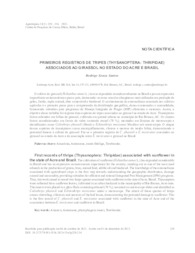Primeiros registros de tripes (Thysanoptera: Thripidae) associados ao girassol no estado do Acre e Brasil.
Primeiros registros de tripes (Thysanoptera: Thripidae) associados ao girassol no estado do Acre e Brasil.
Author(s): SANTOS, R. S.
Summary: O cultivo do girassol (Helianthus annus L.) tem se expandido consideravelmente no Brasil e possui expressiva importância socioeconômica para o país, destacando-se como uma das oleaginosas mais utilizadas em produção de grãos, farelo, ração animal, óleo comestível e biodiesel. O conhecimento da entomofauna associada aos cultivos agrícolas é o primeiro passo para a compreensão da distribuição geográfica, danos ocasionados e sazonalidade, fornecendo subsídios para programas de Manejo Integrado de Pragas (MIP) eficientes e racionais. Assim, o objetivo desse trabalho foi registar duas espécies de tripes associadas ao girassol no estado do Acre. Tisanópteros foram coletados em folhas de girassol, cultivado em quintal urbano no município de Rio Branco, AC. Os insetos foram acondicionados em frasco de vidro contendo etanol (70 %), montados em lâminas de microscopia e identificados como Caliothrips phaseoli (Hood) e Echinothrips mexicanus Moulton sob microscópio. O ataque dessas espécies de tisanópteros causa encarquilhamento, clorose e necrose do tecido foliar, demonstrando o potencial danoso à cultura do girassol. Faz-se o primeiro registro de C. phaseoli e E. mexicanus associados ao girassol no estado do Acre e da associação entre E. mexicanus e girassol no Brasil. The cultivation of sunflower (Helianthus annus L.) has expanded considerably in Brazil and has an expressive socioeconomic importance for the country, standing out as one of the most used oilseeds in the production of grains, bran, animal feed, edible oil and biodiesel. The knowledge of the entomofauna associated with agricultural crops is the first step towards understanding the geographic distribution, damage caused and seasonality, providing subsidies for efficient and rational Integrated Pest Management (IPM) programs. Thus, this work aimed to record two thrips species associated with sunflower in the state of Acre, Brazil. Thysanoptera were collected from sunflower leaves, cultivated in an urban backyard in the municipality of Rio Branco, Acre state. The insects were placed in a glass flask containing ethanol (70 %), mounted on microscope slides and identified as Caliothrips phaseoli and Echinothrips mexicanus under a microscope. The attack of these species of thrips causes shriveling, chlorosis and necrosis of the leaf tissue, demonstrating the potential damage to sunflower. This is the first record of C. phaseoli and E. mexicanus associated with sunflower in the state of Acre and of the association between E. mexicanus and sunflower in Brazil.
Publication year: 2021
Types of publication: Journal article
Unit: Embrapa Acre
Observation
Some of Embrapa's publications are published as ePub files. To read them, use or download one of the following free software options to your computer or mobile device. Android: Google Play Books; IOS: iBooks; Windows and Linux: Calibre.
Access other publications
Access the Agricultural Research Database (BDPA) to consult Embrapa's full library collection and records.
Visit Embrapa Bookstore to purchase books and other publications sold by Embrapa.

